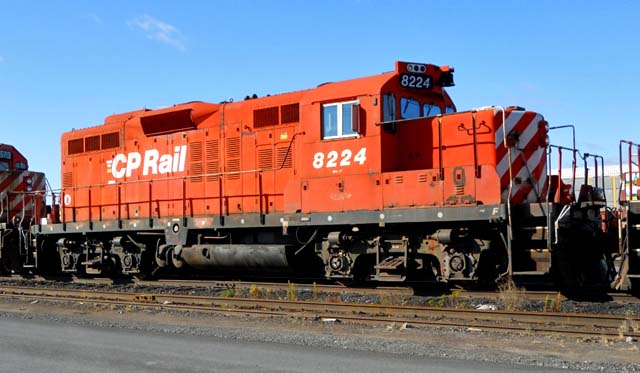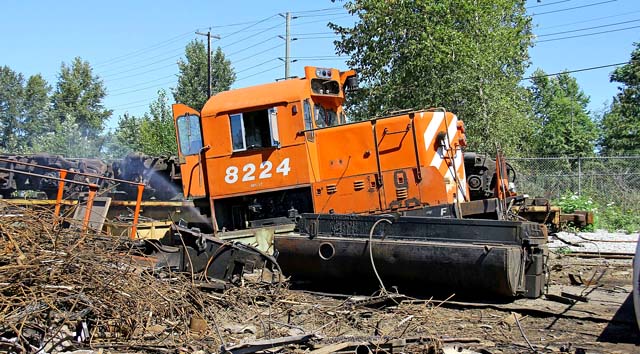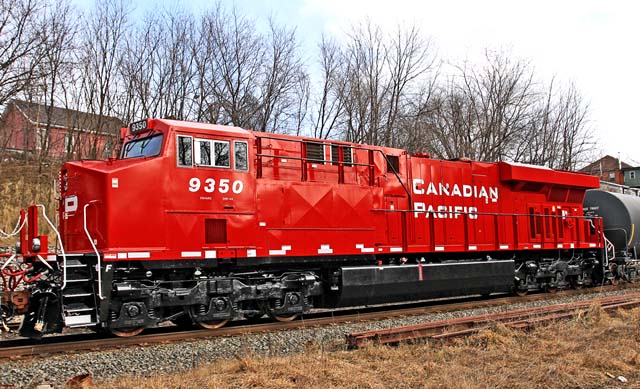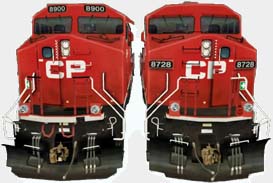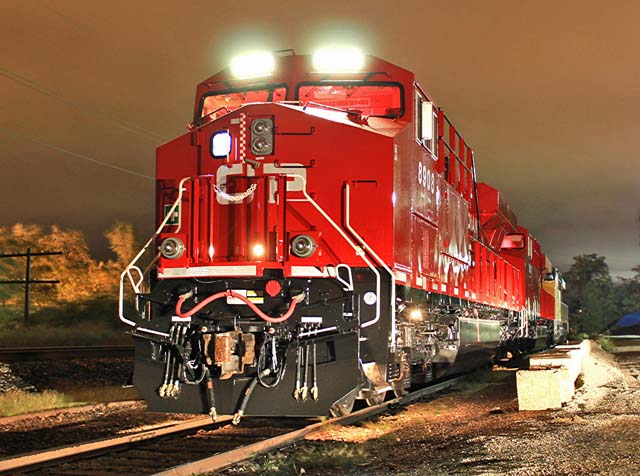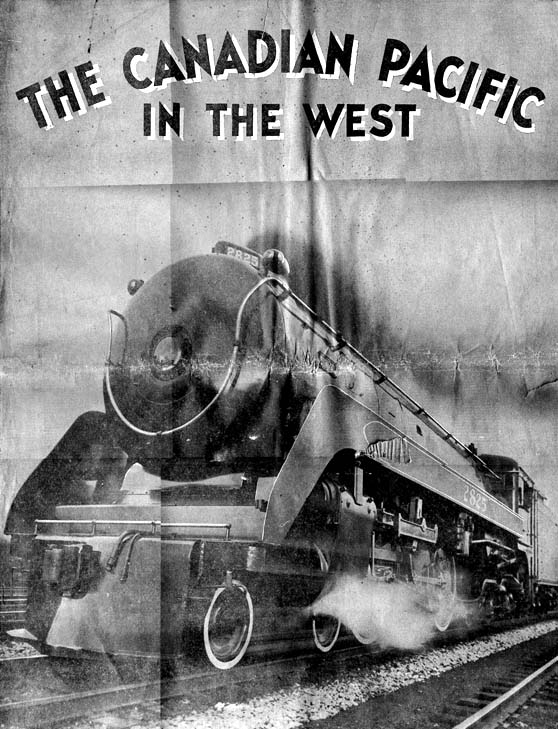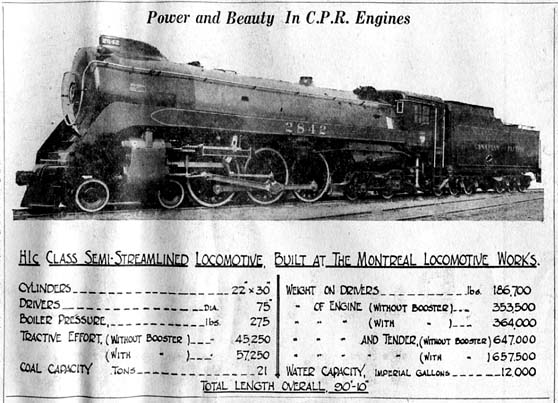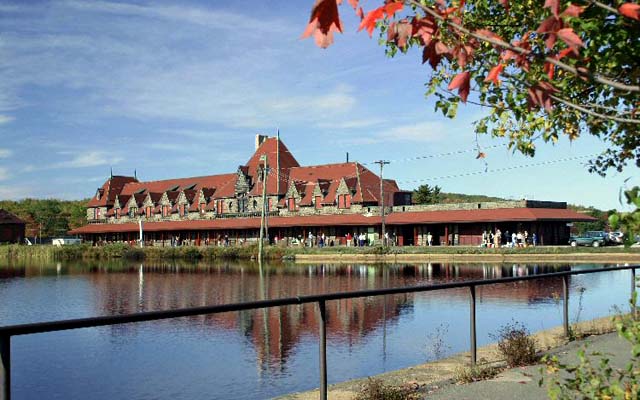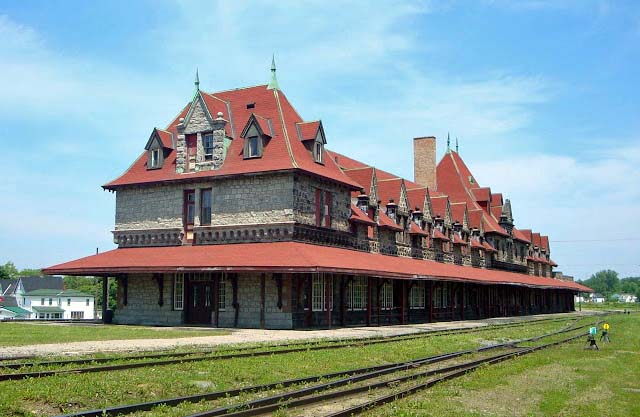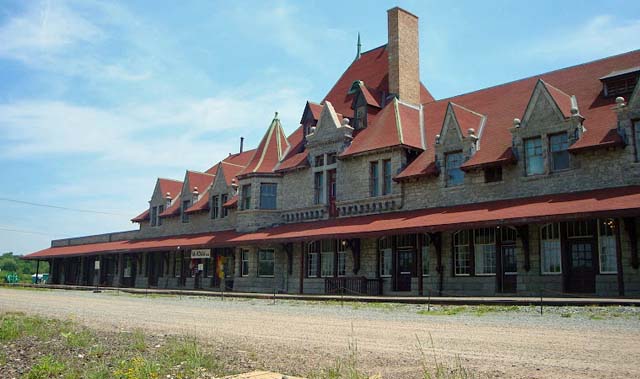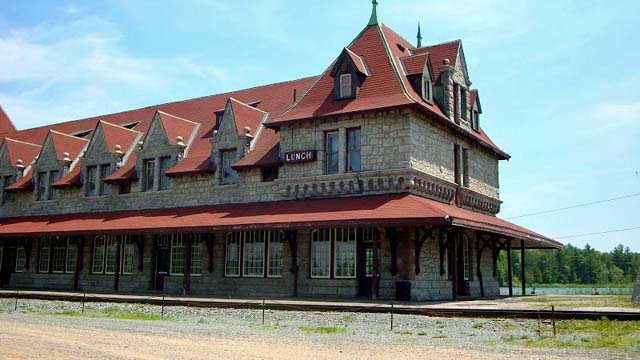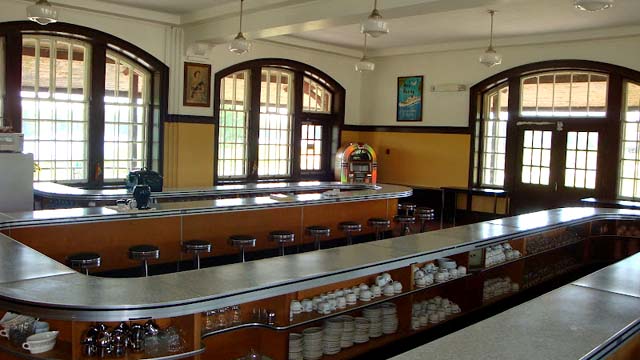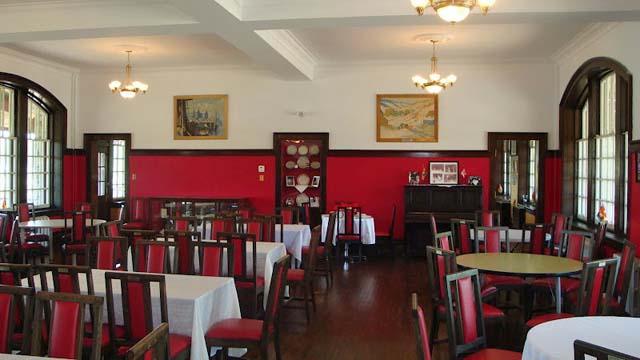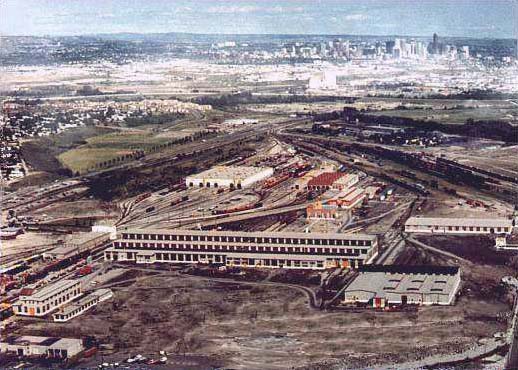 Table of Contents Death of a Diesel - The Diesel Doctor 2012.
The Latest Canadian Pacific GE ES44AC - The Diesel Doctor 2012.
Improved Fire Kindlers - Locomotive Engineering 1898.
New Semi-Streamlined Power for Canadian Pacific Trains - Winnipeg Evening Tribune 1937.
Canadian Pacific Railway McAdam Station - Canada's Historic Places.
History of Ogden Shops - Railway Stories from the Past 2011.  Introduction The "Last Call" page has appeared weekly on OKthePK's web site over the past couple of years. Each week a different article told the story about various railway items of interest. While some of the articles were saved they were no longer available online. Several of those about the Canadian Pacific Railway have been compiled here on this page. There is insufficient room to display more than a few articles per page. As a result, "Canadian Pacific Odds and Ends - Part 3", continues this month with more parts to follow as time progresses. Every month they will be archived to the CPR Set-off Siding web site for future online retrieval. Look under the articles section on the CPR Set-off Siding web site to find these archived pages.  Death of a Diesel | 4 August 2012 | Andy Cassidy |
Canadian Pacific number 8224 - 11 Jul 2010 Richard Marchi.
Canadian Pacific number 8224 - 4 Aug 2012 Andy Cassidy. Vancouver British Columbia - The West coast has finally got some major heat 33C (91F).
Too hot for walking about, so we drove across the river to Surrey and made our way over to ABC Metals at milepost 22.0 of the Canadian Pacific Page Subdivision to see what was happening there.
CP 8224 was the only unit on the chopping block, so I managed to get a few shots of what's left of her.
It was like an oven in that scrap yard, so I only hung around for a few minutes to get the pictures and chat with one of the crew.
I felt sorry for the guy, having to work there all decked out in coveralls and other PPE.
He must have been cooking!
Her trucks have been loaded onto a flat car, and there were also some others from previous victims resting there.
The engine is standing proud in the sun, but will no doubt be reduced to small chunks by the big shear in the background in short order.
It's sad to see all these good old GP's going down for the count.
With this, and all the shots of the dismantling of the Chalk River Sub, you'd think the whole railway was just being dismantled.
On a somewhat lighter note, it seems with every unit that's come here there's also been a Switch Broom going down with the ship, hanging on to the short nose ladder rung till the end.
Andy Cassidy.
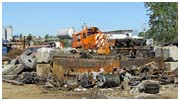 4 Aug 2012 Andy Cassidy.
| 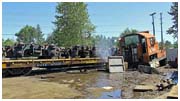 4 Aug 2012 Andy Cassidy.
| 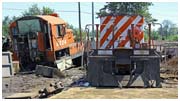 4 Aug 2012 Andy Cassidy.
| 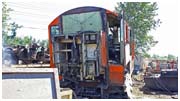 4 Aug 2012 Andy Cassidy.
| 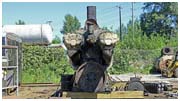 4 Aug 2012 Andy Cassidy. | 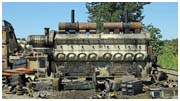 4 Aug 2012 Andy Cassidy. |
 The Latest Canadian Pacific GE ES44AC General Electric built ES44AC Canadian Pacific Railway number 9350 - 29 Feb 2012 Dan Tweedle. Calgary Alberta - Canadian Pacific is currently receiving thirty new General Electric locomotives model ES44AC.
These Tier 3 units are similar to the previous locomotive order. Road numbers for these new locomotives are CP 9350-9379.
The following are the differences compared to the previous orders:
The locomotives have provision for Electronically Controlled Pneumatic Brake (ECP). There are ECP electric jumper cables on each end of the locomotive. Each jumper cable has an inline dummy connector to tie up the cable when not in use. It is important that the cable be tied up when not in use to prevent damage. (ECP is NOT operational at this time.)
The conductor's and engineer's seats have been sourced from a new supplier, Seats Incorporated. These seats have been approved by the CP Locomotive Cab Committee and were installed on the previous order. Adjustment mechanisms differ from the current Air Chief seats. Adjustment instruction can be found on the back of the seat. The arm rest must be placed in the full upright position before they can be adjusted.
The control of the horn is interlocked with the position of the Generator Field switch. The GF switch must be ON to operate the horn. This was done to prevent accidental operation of the horn when entering and leaving the control stand.
These locomotives are built in accordance with the new AAR crashworthy specification. This includes movement of the nose cab door from the conductor's side of the locomotive to the engineer's side. The door is heaver and may require more effort to open and close. The number boards have also been relocated, and are now above the windshield.
Locomotives are equipped with a sliding deadbolt lock. The standard CP coach key will not work. Supply Services will eventually provide new keys.
Locomotives are equipped with a bilingual decal package. Warning/Instructional decals and placards are in both English and French. The SIDS screen can be viewed in English or French via the soft key menus.
Locomotive operator cab controls i.e., lights, HVAC, horn, and sand, are now identified with icons to comply with AAR standard S-5514.
The electric window heaters are now on a 20 minute timer. A momentary toggle switch on the console starts the timer.
An LED lighting package has been offered which includes various LED light fixtures within the cab. The dome light will glow red when an Emergency Brake application is made. The light will automatically go out when the air brakes are recovered. The red light can also be turned off manually by holding up on the emergency lights off switch on the control stand.
Locomotives are equipped with an electric parking brake. The hand brake can be applied or released either electrically via push buttons, or manually by turning the hand wheel. When the electric hand brake is engaged, the hand wheel does not rotate. A light on the Engine Control panel named "hand brake not released" light indicates when the hand brake is applied. If the reverser is placed in a direction with the hand brake applied, a "wheel slip" indicator will be displayed on the Smart Screen (SIDS).
Radio speakers are provided above the engineer, and conductor's positions. The speakers are equipped with individual volume controls.
The brake pipe (BP) cut-out cock has been relocated behind the stairway just below the running board.
The SBU/EOT basket has been relocated and re-designed. The SBU/EOT bracket is now located on the rear of the fuel tank on the conductor's side.
Standard luminescent emergency decals are provided in the operators cab.
Locomotives are factory equipped with FTO.
Two brand new Canadian Pacific ES44AC units, and 1 Union Pacific Gevo await pick up in Erie, Pennsylvania. The red lights inside the cab of 8908 turn on whenever the locomotive goes into emergency - 26 Sep 2012 Steven Mckay.  Improved Fire Kindlers The report on Locomotive Fire Kindlers submitted to the last Master Mechanics' Convention shows that within the last two years wonderful progress has been made in changing from the old-fashioned, dangerous, dirty practice of kindling fires with wood to methods that are in every way superior. The Leslie kindler, which uses oil in a perfectly safe way, is now in use in nearly one thousand engine house stalls, and the Smith kindler is making steady progress into popularity. The impetus from investigating improved methods of kindling locomotive fires has done much to induce railroad companies to try departure from the wood pile. There is no doubt that the use of oil for kindling fires is cheaper and safer than wood, and it only remains for continued success with this method to bring into line the companies who are holding on to the old practice through force of habit. A fire kindler which appears to be much less expensive than wood, and placates the prejudices of those who are opposed to the use of oil, is the Le Bel, which is largely in use on the Canadian Pacific, and is used in a limited way on the Fitchburg and the Vermont Central railroads. This kindler is made into bricketts, and is composed of resin, coal oil, and sawdust. Those who have had experience with this kindler speak highly of its convenience and efficiency. Speaking of this kindler, Mr. R. Atkinson, mechanical superintendent of the Canadian Pacific, said:
"I have tried the Le Bel kindler and it has worked well. It did not work well at first. We did not know how to use it. We commenced in the ordinary way to put the kindler below the coal. We afterwards found out it would be better to make a mound of the coal and put the kindler oil on the top, being of a resinous nature it melts and runs down in the body of the coal. I conducted a test between two sister engines, one with wood and one with the Le Bel kindler, cold water in each case, engines in the same condition so far as we could ascertain, and the assertion was made that we should debit the Le Bel kindler with the cost of more coal as an off-set to the heat of the wood in the other case, but we found in the course of the experiments that we had to put the same amount of coal oil in each case, in fact, that it was not a question of raising steam, it was a question of getting a body of fire ready to go in service. I put 600 pounds of coal with five sticks of the Le Bel kindler in the firebox of an eight-wheel engine. I did not put all the coal in at one time, 300 pounds to begin with, and afterwards the balance, and I think I have here the time of raising steam."
"The first steam showed in 53 minutes, and 70 pounds of steam in 78 minutes. When the engine was loaded up with wood immediately afterwards, I used 95 pounds of the best dry pine scantlings that we had, without any sap wood or bark, and the first steam showed in 37 minutes, and 70 pounds in 57 minutes. But the fire on which I had put only 500 instead of 600 pounds of coal, in the case of the Le Bel kindler, was more thoroughly burned through at that time, and, therefore, the next increase of steam up to 120 pounds was got more slowly. When I got 120 pounds of steam with the Le Bel kindler I had a fire something like 3 inches thick and ready to go out with the train, and, in fact, it went out as soon as I could let it go. The other had to wait while I put another 100 pounds of coal on before she was ready to go. So that we consider that the number of sticks of kindler used was the total cost required."
"I understand that they are selling that kindler at a cent a stick. I must say it is very handy. The locomotive foreman can keep his box of kindler in his office, and hand out the number of sticks required. There is no loss of any kind, and we might almost say no fire risk, because you keep the box in a corner of the office and there is only the ordinary risk of all office fires. To start it, we put on a little oily waste generally. You need not do so, but we have oily waste around and might as well burn it. There is a very great gain in that we have such a small amount of carriage to pay for. We have so many hundreds of miles where there is not a stick of wood, and the wood has to be hauled there, and we can haul a cartload of kindler for probably about one-sixtieth or one one-hundredth of what it would cost to haul the necessary amount of wood to fire the same number of engines."
It would seem from this that fires can be kindled for five or six cents each, which is a very great saving compared with wood. Oil costs about two cents for each engine fired up, but there is more coal used than there is when wood is employed. Both systems indicate a decided improvement over wood.
The objection has been raised to these improved methods that they may be harder on fireboxes and cause more cracking of sheets and breakage of stay-bolts. The matter is worthy of investigation, but we question if there is anything to it. Those who have been wedded to old practices generally imagine difficulties in the way of change, and it seems to us that the objections to the improved fire kindler come principally from conservative impulses.  New Semi-Streamlined Power for Canadian Pacific Trains
8 December 1937
Advanced in design and capable of creating impressive records on transcontinental runs the Canadian Pacific Railway has just put 30 new 4-6-4 Hudson type locomotives into service. Power, speed, and a semi-streamlined appearance are the outstanding features of these locomotives.
A picture of this engine is shown in the full page illustration on the cover of this section.
Designed by the motive power department of the company and constructed by Montreal Locomotive Works, the 30 new engines will be capable of hauling long transcontinental trains more than 800 miles without change of locomotive. They have been assigned numbers 2820 to 2849 inclusive.
H.B. Bowen, chief of motive power and rolling stock, has embodied in the design of the new locomotives the popular semi-streamlined appearance which he first developed in the Jubilee type engines, as well as many of the other interesting details which were incorporated in the Jubilee design, and which have been proven to be satisfactory in service. The exterior of the locomotive is smooth and modern in appearance, with no projecting headlight, smokestack, or domes. Sloping lines of the front plates merge into the horizontal lines of running boards and boiler in such a manner as to convey an appreciation of the capacity for sustained high speed inherent in the design.
Capable of Long Runs
One of the most important possibilities is in hauling heavy trains for great distances without change of locomotive. Five of the new engines, 2838 to 2842, are equipped with the latest design of locomotive booster. These will see service between Toronto and Fort William, 813 miles, without change of locomotive. The boosters will assist in making smoother start from stations and will be of great value in maintaining schedules on long passenger trains numbers 3 and 4 over the heavy grades and on the curve conditions encountered on this run. New engines will also be placed on through runs of 832 miles between Winnipeg and Calgary and other long runs are under consideration.
Tentative arrangements were made during the past month to put four of the new locomotives on trains 3 and 4 between Toronto and Fort William. Seven will go into passenger service between Montreal and Quebec, while three others will be used on freight service on the same run in the winter and on extra passenger trains in the summer. The remaining 16 locomotives will be used on the transcontinental service on Western Lines, between Fort William and Vancouver.
They are capable of any speed required of them and when in freight service will, with the booster, haul more cars than the average freight locomotive. On the subdivision, Smith Falls to Montreal, one of these engines using booster, giving it a tractive effort of 57,000 pounds, would haul 4,789 tons, or approximately 100 loaded freight cars. Without booster, the engines have a tractive effort of 45,000 pounds, and with driving wheels six feet three inches high they can haul these heavy freight trains at a high rate of speed.
They have a boiler pressure of 275 pounds per square inch and to maintain this pressure they have a firebox approximately 11 feet long and seven and a half feet wide, or about the floor space of a room in an apartment house. The boilers have adequate capacity of steam required for heavy, fast, through passenger trains.
Impressive Fleet
The new locomotives are known as the Hudson type, 4-6-4, the figures referring to the wheel arrangement of four small smaller wheels on the leading or pony truck, six coupled driving wheels, and four smaller trailing wheels. The company already had 20 in service, numbers 2800 to 2819, which, with the 3100 series 4-8-4, the Jubilee type 3000 series 4-4-4, and other recent additions give the Canadian Pacific one of the largest fleets of powerful modern locomotives on the American continent. The earlier 2800's have already proven their worth and other progressive roads have adopted this type, considering it the latest development in steam tractive power.
Many of the features developed by the company in the first 2800's have been incorporated in the new lot of 30, as well as features from the Jubilee type. The cylinders, frames, valve motion, and other details, with some modifications developed by experience, are, in general, the same as in locomotives 2800 to 2819, but due to semi-streamlining the appearance has been changed, while, in addition, efficiency in operation is aided by a new positive type of air reverse gear, also a Canadian Pacific development. The arrangement of valves and fittings in the cab has been made very convenient for operation and access.
The first of this new group of 30 locomotives have recently made their appearance in service and the comment of locomotive experts, railwaymen in general, and the public has been most gratifying. Performance in freight service, where new locomotives are always "broken in", had been very satisfactory, demonstrating that the company has power that compares favourably with any in existence.
The Specifications
Cylinders ... 22" x 30"
Diameter of Driving wheels ... 75"
Boiler pressure ... 275 lbs.
Tractive effort ... 45,250 lbs.
Tractive effort with booster ... 57,250 lbs.
Wheelbase driving ... 13' 2"
Wheelbase engine and tender ... 30' 6"
Firebox length ... 10' 6 1/4"
Firebox width ... 131 1/16"
Grate area ... 80.8 sq. ft.
Heating surface flues and tubes ... 3,500 sq. ft.
Heating surface firebox and arch tubes ... 361 sq. ft.
Heating surface superheater ... 1,640 sq. ft.
Heating surface total ... 5,501 sq. ft.
Weight on driving wheels ... 186,700 lbs.
Weight engine total with booster ... 364,000 lbs.
Weight engine and tender ... 657,500 lbs.  Canadian Pacific Railway McAdam Station Canadian Pacific Railway McAdam Station 146 Saunders Road McAdam New Brunswick Canada - Date? Photographer? Construction Date
1 Jan 1900 - 1 Jan 1901
Description of Historic Place
The Canadian Pacific Railway station at McAdam New Brunswick is a large Chateau-style station and hotel built in 1900-1901. It is prominently located in Heritage Park surrounded by railway artifacts. It stands on raised land overlooking Saunders Road, McAdam's main street, just in front of an immense pond that has become a sanctuary for wild geese.
Heritage Value
The McAdam station has been designated a heritage railway station on the basis of its historical, architectural, and environmental significance. It has also been commemorated as a National Historic Site in 1976.
This is an imposing Chateau style station designed by prominent Canadian architect Edward Maxwell. It was constructed in 1900-1901 as the CPR emerged from depression to begin two decades of expansion. As McAdam's second station it was much more substantial than its predecessor. Its presence reflects not only the CPR's improved financial status, but also McAdam's prominence as a railway centre. Established as a centre on the original Canadian Atlantic Railway (CAR) line through the maritimes, the village of McAdam thrived after the CPR assumed control of the CAR line in the late 19th century. The station itself was expanded in 1910-1911 (W.S. Painter, architect), and during the 20th century has served the CPR, VIA Rail, and most recently, the CAR which has been revived as an independent CPR subsidiary.
The McAdam station is an imposing example of the Chateau style. The upward thrust of its hipped gable roof and the busy rhythm of its many gabled dormers, turrets, pinnacles, and pavilions, plus the smooth quality of the upper level walls, recall key elements of the style. The station is also a rare surviving example of the combined railway station/hotel, accommodating both station and hotel facilities under the same roof. As a result, the architectural presence of the McAdam station is amplified much beyond that warranted by its functional requirements.
Today the station retains its prominent role as the symbol of McAdam's railway heritage. It sits high on its original site overlooking commercial Saunders Road, adjacent to the track and surviving railway outbuildings. Behind it is a six acre pond originally created to provide water for railway steam engines.
The heritage value of the McAdam station resides in its well-resolved Chateau style design, its materials of construction, and its visual and symbolic prominence.
Source: Heritage Character Statement, Canadian Pacific Railway Station, McAdam, N.B., 19 Dec 1990. Heritage Assessment Report RSR-020, 1990.
Character-Defining Elements
Character-defining elements of the Canadian Pacific Railway Station at McAdam include: - its substantial rectangular footprint and 1 1/2 storey massing under a steeply pitched roof cut by irregular dormers and a 2 1/2 storey tower;
- the lively visual interest incorporated in its roofline by high dormer peaks, the steep pitch and bell-cast edges of the hipped tower roof, the presence of a subsidiary tower with a conical roof, a pair of small symmetrical dormers, and an eyebrow window on the main tower, the generous use of finials and ridge caps, and the presence of prominent chimneys;
- its substantial proportions;
- definition of the ground floor as a series of eight regular bays, seven of which are arcaded;
- the care with which the horizontal balance of the roofline is resolved by counter-balancing the off-centre main tower with a prominent subsidiary tower, and also by the irregular placement of dormers;
- the balance inherent in the station's vertical definition;
- the seamless manner in which the 1910-1911 additions are integrated into the overall aesthetic design of the station;
- the smooth incorporation of special railway features such as a projecting telegrapher's bay and broad eaves at the first storey to provide passenger shelter;
- the station's carefully articulated Chateau-style features, stone-gabled dormers, a tower with a pointed spire, stone corbelled string courses at the second floor level of the central and north pavilions, steeply pitched hipped roofs with bellcast eaves, extravagant roof detail, and a variety of fenestration;
- the varying textures of its original materials, its rough-faced grey granite walls, Welsford red granite window surrounds and quoins, copper roof details, multi-paned windows, wood panelled doors;
- the high degree of craftsmanship evident in its masonry, large, regularly coursed, rough-faced blocks on the walls below the wide platform eaves, and randomly coursed, smoother faced rubble above, dressed stone copings with spherical finials articulating the stone-gabled dormers along the roof, distinctive corbelled string courses accentuating the central and north pavilions;
- continued legibility of the station's dual function as a hotel and station;
- continuing legibility of the volumes and details of its main public features, particularly the large passenger waiting room and dining room occupying the entire width of the building on the ground floor;
- continuing legibility of its original layout and traffic patterns, in particular the double-loaded corridor configuration of the small repetitive offices and hotel rooms on the second floor;
- all original fabric and finishes inside the station, in particular surviving original partitions, wall and floor coverings, surviving millwork including decorative pilasters and beam casings, window and door casings, carved newel posts, and stair components, V-grooved wainscoting, and baseboards, original light fixtures, and furnishings;
- the overall integrity of the building's form, plan, material, and detail.
Canadian Pacific Railway McAdam Station - Date? Photographer? Canadian Pacific Railway McAdam Station - Date? Photographer? Canadian Pacific Railway McAdam Station - Date? Photographer? Canadian Pacific Railway McAdam Station lunch counter- Date? Photographer? Canadian Pacific Railway McAdam Station dining room - Date? Photographer?  History of Ogden Shops Aerial view of Ogden Shops - Date? Photographer? Calgary Alberta - Next time you enter the Ogden Shop gates, are you aware that you are entering a significant piece of Calgary and Canadian History?
Construction of Ogden Shops was started in May of 1911 and for the next 11 months, as many as 500 people swarmed all over the work site. In March of 1912 the Ogden shops were officially opened.
The staff at that time peaked at 1,400 employees. During the Great Depression the staff dwindled down to 600 employees, who worked only 10 days a month. Ogden Shops was a big employer of many newly arrived immigrants.
The approach of the Second World War brought renewed activity at Ogden Shops. The need for locomotives and cars soon restored staff and production to their former heights. However, the need for armaments was even greater and in 1941 the shops were re-fitted to make 3 inch Naval guns for the war effort. By the time peace was restored Ogden shops had turned out 30 million dollars of war armament. Some of these guns can be viewed at the military museum in Calgary.
The early site was made up of many shops. The largest was the locomotive shop with 26,000 square feet (21,000 square meters). Many satellite shops were added such as the wheel shop, air brake shop, car shop, paint shop, carpentry shop, foundry, and others.
So next time you pass by remember you are looking at almost 100 years of history.
Bill Banner.  The photo above of Ogden Shops in Calgary shows 4-inch naval guns and their mountings. The Ogden Shops produced two types of 4-inch naval gun mounts, which were installed on warships, while the gun barrels themselves were produced elsewhere in Canada. The shops produced naval guns for Canadian, British, and American ships, manufacturing more than 3,000 naval guns and 1,650 naval gun mounts. The 4-inch gun was the largest artillery piece produced in Canada during the Second World War - April 1945 George Metcalf Archival Collection. 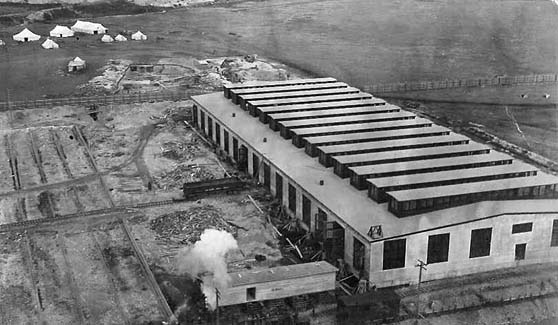 The picture above shows No. 2 Coach Shop under construction, to the east outside the fence surrounding the shops you can see tents were the construction workers lived. It looks like there is a gate where the workers could access the construction site of the structure. The shop has 15 bays to work on CPR's fleet of passenger coaches. The structure with the smoke coming out of its chimney is a temporary structure that was probably used by the construction engineers and draftsmen. To the east of this building and past the railway gondola to the end of shop, a transfer table was built. Coaches entering the shop came onto the table on the center track where the gondola is sitting, and from there the transfer table traveled on rails to any doorway, and the coach would be moved in to the shop for its overhaul. The coaches would be stripped of paint, seats would be removed for re-upholstering, and any other repairs would be done to the running gear and air brakes. The coaches would be re-painted, re-furbished, and moved out of the shop on the transfer table to return to service. At the time I worked at Ogden, the passenger era was in its twilight, many passenger trains were abolished, for lack of business. The automobile and airlines had taken their toll on these trains, and many jobs were lost - Date unknown Larry Buchan.  |


